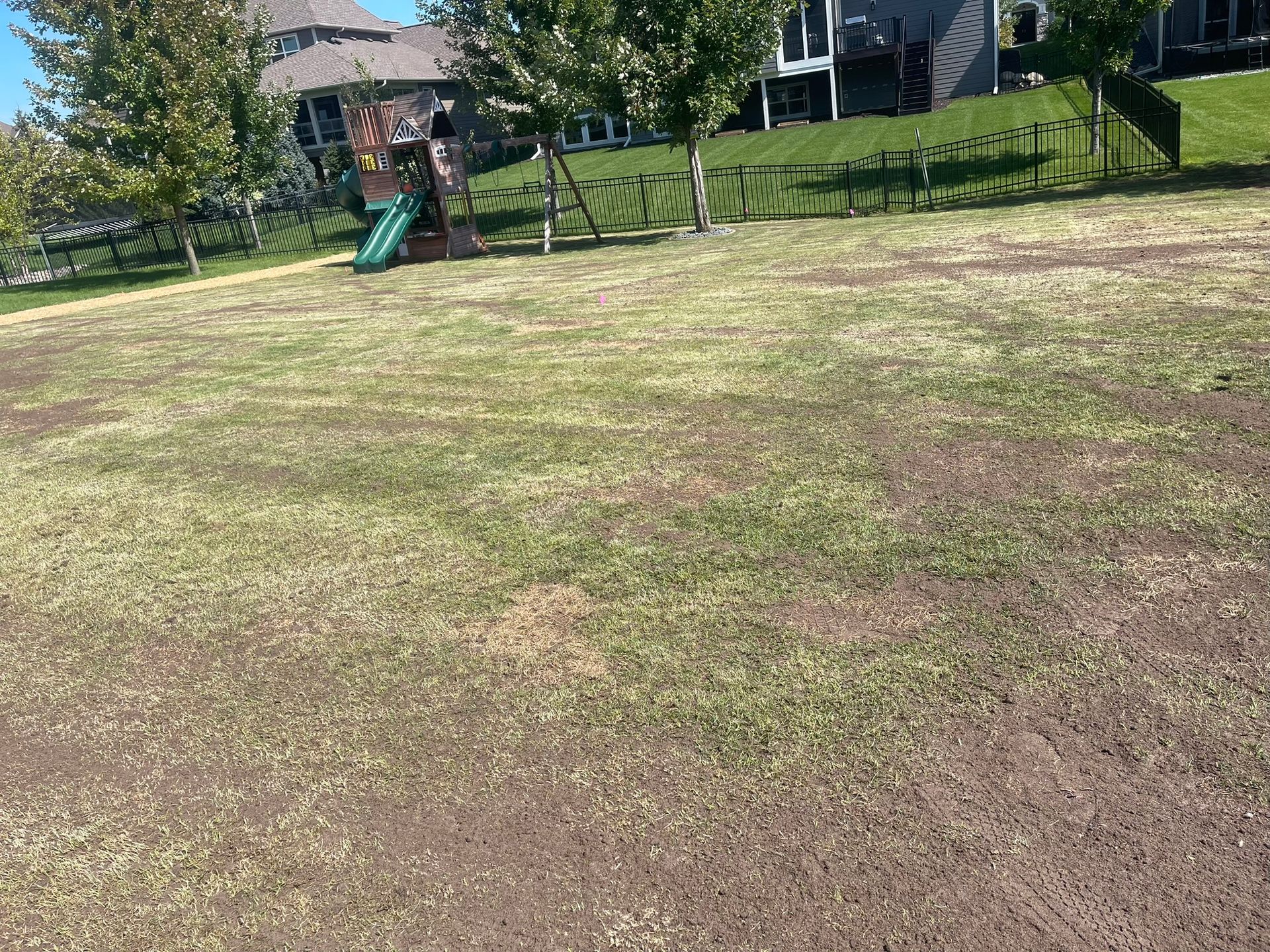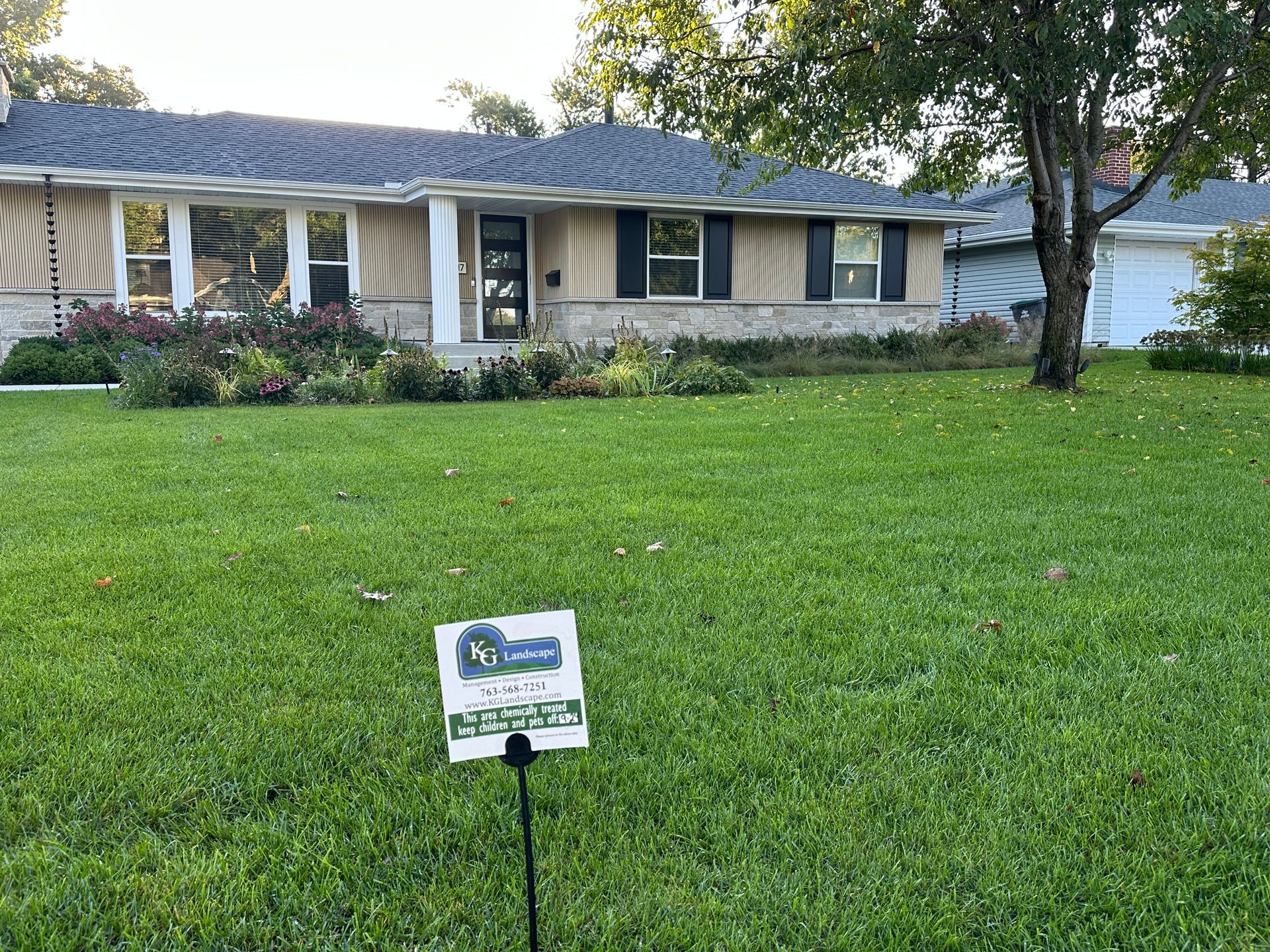Topdressing for Smoother Lawns in Minneapolis
You Can Feel the Problem Before You See It
You can always tell when a lawn needs topdressing. You feel it before you even see it. You step outside to mow, play fetch with the dog, or walk barefoot through the grass, and you notice those dips and soft patches underfoot. In Minneapolis, this is one of the most common lawn complaints I hear from homeowners. Lawns get uneven over time, and most people don’t realize there’s a simple fix that doesn’t involve ripping everything out and starting from scratch.
A lot of the problem comes from how Minneapolis lawns were originally built. Most homes here sit on compacted fill soil that was never really meant to grow perfect turf. Add in years of freezing and thawing, foot traffic, settling, and patchy lawn repairs, and you’ve got a recipe for uneven, soft, or lumpy lawns. I’ve seen yards that slope one way in spring, another way by fall, and hold puddles for days after it rains.
When I talk about topdressing, most homeowners have heard the term but aren’t sure what it means. Some think it’s just a light sprinkling of soil over the grass, but when it’s done right, it’s one of the most effective ways to improve the feel, appearance, and health of a lawn. In my opinion, topdressing is one of the most underrated lawn improvements you can make. It doesn’t look dramatic the day it’s done, but the results you feel under your feet last for years.
In Minneapolis, where we deal with compacted clay soils, topdressing helps create a firmer, smoother surface that feels solid instead of spongy. You can walk across your yard without sinking or stumbling, and mowing becomes easier because the ground isn’t bouncing the mower deck around. It’s also one of the most cost-effective ways to boost your lawn’s health and usability without a full renovation.
If you’ve ever looked out at your backyard and thought, “This just doesn’t feel right,” chances are, topdressing is what it needs.
What Topdressing Actually Does
Topdressing is simple in theory: spread a thin layer of sandy topsoil across your existing lawn to even out the surface. But in practice, there’s a lot of science behind why it works so well.
Clay soils, like the ones we have all over Minneapolis, hold water tightly. The fine particles pack together and make it hard for air and water to move through. That’s why these lawns get soft when wet and rock-hard when dry. When you spread a sandy topsoil mix over the top, it starts to blend into the existing soil profile. Over time, that new layer helps loosen the compaction and lets moisture drain more freely instead of pooling or running off.
The sandy component is key. It fills small dips and levels bumps, but it also changes how the soil behaves. Water can soak down evenly instead of getting trapped near the surface, which keeps the grass roots healthier and stronger. A topdressing layer also helps sm
ooth out the micro-grade of your yard so you can walk, play, or mow without the annoying unevenness.
Another benefit is that it builds soil structure over time. Each time you topdress, you’re slowly improving what’s underneath without tearing up the lawn. After a couple of years of seasonal topdressing, a compacted lawn can feel completely different—firmer, smoother, and far more resilient to foot traffic and weather changes.
We typically use a custom mix that’s heavy on sand with just enough topsoil to help the grass grow through it easily. Too much pure soil and you’re back to compaction problems. Too much sand and you’ll dry the grass out. The blend we use strikes the right balance for Minneapolis lawns—firm underfoot, good drainage, and steady growth.
When people see how much smoother their lawn looks and feels after one good topdressing, they’re usually surprised. It’s not flashy, but it’s one of those small, behind-the-scenes things that completely changes how your yard works.

How I Approach Topdressing for Minneapolis Lawns
When I’m topdressing a lawn, my first goal isn’t just to make it look better. I want to make it function better. That starts with understanding what’s really going on in the yard. Before we bring in any material, we take a look at the grading, drainage, and existing soil type. If the lawn has pooling water or heavy compaction, we might recommend pairing topdressing with aeration or minor grading adjustments.
Once the plan is in place, we mow the lawn short to expose the surface and make sure the material blends well. Then we apply the sandy topsoil mix using wheelbarrows or mechanical spreaders, depending on the size of the yard. The key is to get an even layer—just enough to fill the low spots without smothering the grass. We rake it lightly so it settles into the turf canopy, then water thoroughly to help the soil integrate.
Timing is everything. In Minneapolis, early spring or early fall are the best windows for topdressing. The grass is actively growing, the weather is mild, and there’s less stress on the lawn. The material has time to settle in and fuse with the existing soil before winter or the heat of summer.
For lawns that are heavily uneven, we might repeat the process annually for a couple of years to build the surface up gradually. Each round of topdressing smooths things a little more until the lawn has that firm, level feel you’d expect from a professionally maintained property.
There’s also a real aesthetic payoff. A properly topdressed lawn just looks finished. The edges are cleaner, the surface is uniform, and you can tell at a glance that it’s been maintained with care. But the biggest difference you’ll notice is how it feels when you walk across it. That soft spongy bounce is replaced by solid, supportive turf that drains better, stays greener, and holds up to everything from lawn games to backyard parties.
When Topdressing Makes the Biggest Difference
Topdressing is one of those things that benefits almost any lawn, but there are times when it makes the biggest impact.
If you live in one of Minneapolis’s older neighborhoods, your lawn probably wasn’t built with today’s soil standards in mind. Over time, the topsoil layer thins out, and the underlying clay takes over. That’s when you start to notice lumps, soft spots, and poor drainage. A single round of topdressing can make a huge difference, especially if paired with aeration.
It’s also valuable after any kind of construction or landscaping project. If you’ve installed a patio, pool, or drainage system, the soil around those features can settle unevenly. Topdressing helps blend everything back together and create a seamless transition from the new work to the existing lawn.
I also recommend it for high-traffic yards. Families with kids or dogs tend to see more ruts and uneven patches from repeated wear. A topdressing mix reinforces those areas, keeping them firm and safe.
The beauty of topdressing is that it’s not just a cosmetic fix. It’s preventive maintenance. By improving soil structure and drainage, you’re protecting your investment in your lawn, your landscaping, and even nearby hardscapes like patios or retaining walls.
And while it’s tempting to DIY this, I’ll be honest—most DIY topdressing attempts don’t go well. The wrong soil blend, too thick a layer, or uneven application can smother the grass or make things worse. We use a material that’s specifically blended for Minneapolis conditions, and we’ve spent years refining our technique to get consistent, smooth results.
When we finish a job, I can tell immediately by walking across the lawn whether it’s right. It should feel level, springy, and firm underfoot—like it’s ready for anything. That’s the goal every time.

FAQs
How often should you topdress a Minneapolis lawn?
Most lawns only need a full topdressing every one to two years. If your yard is especially uneven or compacted, doing it annually for a couple of seasons will gradually even it out. After that, you can move to a maintenance schedule every few years. The key is consistency—topdressing works best as part of an overall lawn health plan, not as a one-time fix.
What’s the best time of year for topdressing?
In Minneapolis, early spring or early fall are ideal. The grass is actively growing, the soil is workable, and there’s less stress from heat or drought. You want to give the lawn time to recover and grow through the new layer before it goes dormant.
Can I combine topdressing with aeration or overseeding?
Absolutely. In fact, that’s the best way to do it. Aeration opens up the soil so the topdressing mix can settle deeper, and overseeding afterward helps fill any thin spots. The combination leads to stronger root systems and better overall turf density.
What materials are used for topdressing, and why is sandy topsoil better?
We use a sandy topsoil blend because it improves drainage and resists compaction. Regular soil alone can make problems worse, especially in Minneapolis’s clay-heavy yards. The sand component adds structure and keeps the surface firm underfoot while still allowing healthy root growth.
Does topdressing help with drainage and lawn health, or just appearance?
Both. The sandy topsoil mix improves how water moves through the lawn, reducing pooling and soft spots. At the same time, it builds a stronger, healthier root zone. The surface looks better, but the benefits underneath are what really make it worthwhile.
If your Minneapolis lawn feels uneven, soft, or full of puddles after every rain, it might not need to be replaced—it just needs topdressing done the right way. Reach out to KG Landscape to schedule a consultation. We’ll help you create a smoother, stronger lawn that looks and feels better underfoot year-round.










